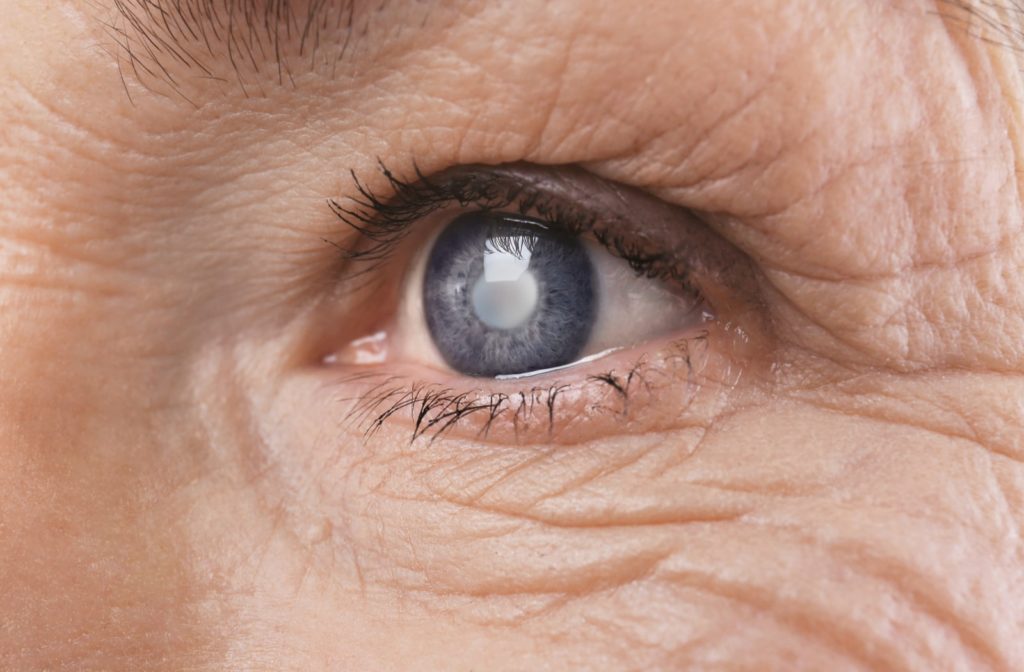Yes, one type of glaucoma—open-angle glaucoma, is hereditary. That means that people with a family history of glaucoma are at a higher risk of developing the condition. However, anyone can get glaucoma.
There are no noticeable symptoms of glaucoma, which is why you need regular eye exams to help detect it in the early stages before significant damage occurs. Glaucoma is one of the leading causes of blindness in Canada, and early treatment can reduce your risk of vision loss.
What Is Glaucoma?
Glaucoma is a group of eye diseases that damage the optic nerve, which carries visual information from the eye to the brain. It can affect individuals at any age but is more common in older adults.
Increased pressure in the eye (intraocular pressure) is responsible for the damage to the optic nerve. Fluid or aqueous humour in the eye usually drains from the eye, but if it builds up, it elevates eye pressure. As the optic nerve gradually deteriorates, you develop blind spots in your vision.
Types & Symptoms of Glaucoma
Symptoms depend on the type of glaucoma and usually don’t show in the early stages of the disease. As the disease progresses, more severe symptoms may develop.
Congenital Glaucoma
With this form of glaucoma, children are born with glaucoma or develop it in the first few years of life. Optic nerve damage can result from an injury, blocked drainage, or an underlying medical condition.
Symptoms of glaucoma in infants and children can include:
- A dull or cloudy eye
- Increased blinking
- Tears without crying
- Blurred vision
- Nearsightedness that gets worse
- Headache
Open-Angle Glaucoma
This is the most common form of glaucoma, where parts of the drainage system (trabecular meshwork) don’t drain properly. It can lead to a slow, gradual increase in eye pressure.
Symptoms of open-angle glaucoma can include:
- No symptoms in early stages.
- Gradual loss of side (peripheral) vision, such as patchy blind spots.
- Loss of central vision in later stages.
Angle-Closure Glaucoma
This type of glaucoma occurs when there is a partial or complete blockage of the drainage angle due to a bulging iris. The pressure increase in the eye can occur gradually or suddenly.
Symptoms of acute angle-closure glaucoma can include:
- Severe headache
- Severe eye pain
- Nausea or vomiting
- Blurred vision
- Halos or coloured rings around lights
- Eye redness
Normal-Tension Glaucoma
In normal-tension glaucoma, there is optic nerve damage when the eye pressure is normal. The exact reason is unknown, but the optic nerve may have less blood flow due to the buildup of fatty deposits in the arteries (atherosclerosis).
Symptoms of normal-tension glaucoma can include:
- None in the early stages
- Gradual blurry vision
- Loss of side vision in later stages
Risk Factors for Glaucoma
Not all cases of glaucoma are inherited. Several other risk factors for glaucoma include:
- Age: over 55
- High intraocular pressure: the biggest risk factor for glaucoma
- Medical conditions: like diabetes, migraines, and high blood pressure
- Thin corneas
- Refractive errors: extreme nearsightedness or farsightedness
- Eye injury or eye surgery
- Steroids: taking corticosteroid medicines, especially long-term use of eye drops
One or more of these risk factors does not mean a person will develop glaucoma. But regular or more frequent eye exams help to test for and diagnose serious eye conditions such as glaucoma. These tests can include:
- Tonometry to measure intraocular pressure
- Dilated eye exam to check for optic nerve damage
- Visual field test to check areas of vision loss
- Pachymetry to measure corneal thickness
- Gonioscopy to inspect the drainage angle
Treatment for Glaucoma
Optic nerve damage isn’t reversible, but treatment can help slow or prevent vision loss when caught in the early stages. The following treatment options aim to reduce intraocular pressure:
Eye Drops
Prescription eye drops help lower eye pressure by decreasing the amount of fluid your eye makes or increasing fluid drainage from the eye. You may require more than one type of eye drop.
Oral Medication
If eye drops are ineffective in decreasing pressure, medication by mouth can also decrease fluid or improve drainage. These can include beta-blockers or a carbonic anhydrase inhibitor.
Surgery
Laser surgery, microsurgery, and minimally invasive glaucoma surgeries (MIGS) are techniques to lower eye pressure by helping fluid drain from the eye.
Tips to Promote Eye Health If You Have Glaucoma
You can’t totally prevent glaucoma. However, you can take steps to protect your vision and lower your risk:
- Eat a healthy diet to maintain your health.
- Exercise safely, which can reduce eye pressure.
- Limit your caffeine as large amounts may increase your eye pressure.
- Drink moderate amounts of fluids to prevent an increase in eye pressure.
- Take your prescribed medicine.
Glaucoma Screening for Peace of Mind
If you have a family history of glaucoma, you can take steps to protect your eyes. But anyone can take proactive measures to lower their risk and prevent glaucoma from affecting their vision.
Book your next appointment with Eye Effects to screen for glaucoma and other eye conditions.


